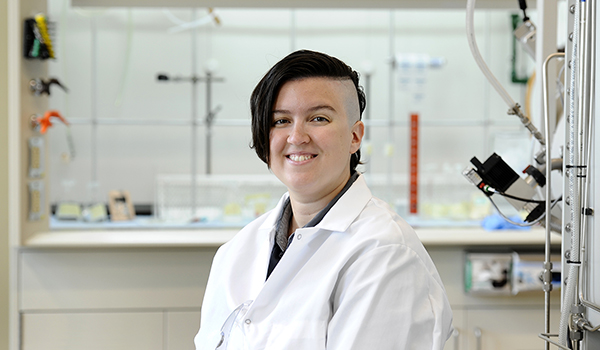STUDENT SUCCESS
McNair Scholar finds niche through undergraduate research opportunities
Published March 2016

First author on peer-reviewed journal articles. Presenter at national conferences. Avid volunteer.
It reads like a checklist of an experienced faculty member. It’s also the budding resume of Mary Hedrick, a senior majoring in chemistry at NDSU. She’s an example of the breadth and quality of research undergraduate students are immersed in at NDSU.
Hedrick started pursuing research opportunities as soon as she arrived on campus. She was a chemistry major, so she joined the lab of Svetlana Kilina, assistant professor of chemistry and biochemistry. There she learned about quantum chemistry calculations, including theories, techniques and modern computational software. Her work resulted in her first paper, with her as first author, published in the Journal of Physical Chemistry in 2013.
If the topic sounds complex—it is. Undergraduates don’t often get the chance to work in computational chemistry, and it’s a significant accomplishment to publish a paper as the lead researcher. But Hedrick likens it to one of her hobbies, art. She views computational work as a way to become creative. “I see the same beauty in art and the beauty in science,” she said.
Hedrick’s research applies to solar and fuel cell technology. She worked in Kilina’s lab for three years, during which she became a member of the McNair Scholars program and received two awards from an international conference on computational chemistry. The McNair scholarship program recognizes students from traditionally under-represented groups in graduate education or income eligible and first-generation students. Scholars must have a strong research interest and be determined to continue on to graduate school.
Growing research experience
In order to expand her research repertoire for graduate school, she began working with Alan Denton, associate professor of physics. She again published a research paper as first author in the Journal of Chemical Physics in 2015.
Her time with Kilina and Denton has been impressive. She:
- Attended 28 conferences in the last four years, including four times at the national meetings of the American Chemical Society. “An amazing experience taking questions from industry, faculty and students,” she said.
- Presented nine oral and 19 poster presentations at state and national conferences, including at the University of California, Berkeley.
- Taught other undergraduates as a teaching assistant in general chemistry labs.
- Awarded the Donald Bolin Memorial Scholarship for excellence in chemistry.
- Served on a Department of Physics faculty hiring committee.
- Volunteered at the Office of International Programs, Office of Multicultural Programs and the physics department’s secondary school outreach programs.
Hedrick’s latest shift is into mechanical engineering, where she studies polymers and coatings. Her research partners were interested in her chemistry background. “If you need to spin coat a polymer, I will figure it out,” she said.
Her two main projects are with area companies. One looks at the feasibility of extracting a high-value dye from specialty crops that could be used in organic foods. The second is identifying sensor technology for determining wide areas of soil conditions in real time. The technology could be used for more precise application of agricultural chemicals.
Hedrick also worked with professor David Wells and graduate student Andy Dalman in the Department of Industrial and Manufacturing Engineering. She applied her chemical expertise to their work on materials compositions for fabrication of artificial bone. She developed a “bone library” that provided the team with up-to-date information on mechanical testing data.
It was just the latest in her academic progression.
“Making switches is OK,” Hedrick said. “You may have a set path, but keep your options open. Faculty and staff are vital to the success of the student. If you’re on this campus doing research, the next experience tends to present itself.”
Path to NDSU
An NDSU alumnus played a key part in steering Hedrick, an Indiana native, to Fargo. She was a struggling student who had not yet found her passion at Indiana University. Then she met Michael Edwards, clinical associate professor of chemistry and the School of Public and Environmental Affairs at Indiana University. Edwards earned master’s and doctoral degrees in chemistry at NDSU.
“Go to NDSU,” he told her. “You’ll like it.”
She does, and the experience from the lab to industry settings makes her well prepared for her next step of graduate school.
“If you show curiosity, the faculty here will facilitate you,” Hedrick said. “NDSU promotes student growth.”
View Hedrick’s publications at:
http://pubs.acs.org/doi/abs/10.1021/jp403819h
http://scitation.aip.org/content/aip/journal/jcp/142/3/10.1063/1.4905574